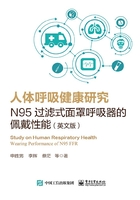
2.1 Introduction
The recent rapid development of industry has created serious environmental pollution problems.Air typically contains harmful chemical substances (e.g.SO2,NOx) and fine suspended particulate matter,especially for respirable PM [e.g.PM10 (PM≤ 10 μm) and PM2.5 (PM ≤ 2.5 μm)] that have harmful effects on respiratory immune function,respiratory and central nervous systems [1].PM2.5 is principally generated from the burning of fossil fuels and volatile organic compounds [2] and is harmful for humans to breathe [3].Therefore,effective protective measures are required to prevent such harmful particles from causing injury.
Respirators are commonly used to avoid airborne dust and many respirators capable of preventing PM2.5 inhalation have emerged in recent years.The N95 filtering facepiece respirator is the current most commonly used PM2.5 respirator.However,there is as yet no clear or enforced classification system for PM2.5 respirators,with many respirators performing poorly in PM2.5 filtration tests.Therefore,further research is required to establish high efficient filter for PM2.5 filtration.
Fibrous filters are widely used in PM2.5 filtration and typically outperform other filtration media.Filtration performance is most commonly measured according to the pressure drop and filtration efficiency,which are mainly determined by the filter's internal microstructure and gas-solid flow characteristics.Numerical simulations of gas-solid flow in various arrangements of fibrous media have been studied by many researchers.Most of these simulations used simple fibrous structures [4-10] and generated two-dimensional (2D) fibrous media,while others applied heterogeneous fibrous structures [11] and generated three-dimensional (3D) layered fibrous structures [12].However,these fibrous models were not based on the actual fibrous media structures and the actual performance of such fibrous media remained unclear.Various novel methods for establishing realistic information about the microstructure of the fibrous media have been proposed.A useful technique was serial sectioning-imaging of the material imbedded in a polymeric resin [13].These acquired 2D images can then be used to virtually reconstruct the original 3D microstructure [14].Along with the above sectioning technique,X-ray microscopy was used to establish the structure and distribution of fibrous materials [15-17].On a parallel track,MRI was also used by many investigators to obtain a 3D image of porous media [18-19].An integrated approach using automated serial sectioning technique,digital volumetric imaging (DVI) and finite volume method (FVM) was presented to obtain a real fibrous media of nonwoven fabrics [20].Using scanning electron microscopy (SEM),Zhu et al.[21] observed the microstructure of fibrous media and generated a 3D model using Matlab and Gambit.This approach was advantageous because fiber structural parameters can be numerically defined and the influence of the fiber parameters on pressure drop and filtration efficiency can be analyzed.In addition,a gas-solid flow model through the fibrous media was studied by combining CFD with particle trajectory simulation [4,6-7],direct numerical simulation method [22-23],Monte Carlo simulation [11,24],Lattice Boltzmann modelling [24-28],the OpenFOAM CFD package with Lagrangian tracking algorithm and a volume-of-fluid (VOF) solver [12],ANSYS-Fluent CFD code [29-30],or a computational fluid dynamics and discrete element method (CFD-DEM) model [2,31].
However,these studies only address that the tendency of the pressure drop and filtration efficiency change with different fibrous structures,SVF and other external factors such as face velocity and particle size.Optimized structures for particular particle sizes have not been investigated yet.In addition,all of above cited studies used a microcosmic geometry model without considering the thickness of the fibrous media.As such,improvements in filtration efficiency are a result of increased fibrous media thickness.Beyond a certain thickness,filtration resistance and pressure drop increase rapidly,which will reduce filtration performance.Therefore,an optimal PM2.5 filter should be characterized by a higher filtration efficiency and a lower pressure drop.
Results of pre-existing studies have some theoretical and practical significance for developing filtration theories and improving filtration performance of filters.Some researchers invented high-performance air filters on the basis of the previous study of the fibrous filtration.Liu et al.[32] developed a transparent air filter with high filtration efficiency for PM2.5.The filter has a specific microstructure to achieve transparent property,high air flow and high filtration efficiency.Nemoto [33] proposed a simple freeze-drying procedure to produce a nanocellulose and high-performance air filters.So the previous studies have a good application at the experimental manufacture.However,the study about the fibrous filtration is still a significant task.The more realistic computing model,more optimized microstructure and a better way to compromise between air-flow and filtration efficiency are all needed to be explored.
This chapter investigated the filtration performance of a multi-fiber filter.Firstly,it built 3D models of the parallel and staggered filters.The models'filtration performances were compared using the commercially available software ANSYS Fluent with a discrete phase model (DPM).In this simulation,the arrangement of fibers,fiber diameter,SVF,face velocity and particle size were considered.The staggered design was subsequently divided into three layers and optimized to achieve a higher filtration performance.The ways of optimization of the filtration performance can provide valuable advices for the production of high-performance filters.